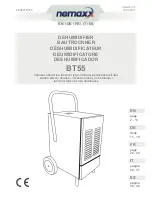
15
CTK 190 mobile air dehumidifier
7.0 Unit description
Operating sequence
The units are switched on and off
by the power key.
The fan extracts the moist room air
through the intake grill with filter,
evaporator and the condenser
behind.
Heat is removed from the room air
on the cold
evaporator
. The air is
then cooled to below dew point.
The water vapour contained in
the room air is then deposited
as condensate or rime on the
evaporator fins.
On the
condenser
(heat
exchanger), the cold and
dehumidified air is warmed up
again and discharged back into
the room via the outlet grill
with a temperature increase of
around 5 - 10 °C above the room
temperature.
The processed, dry air then re-
mixes with the room air.
Continuous circulation of the room
air through the unit gradually
reduces the relative humidity
(% RH) in the room to the desired
humidity level.
Depending on the room air
temperature and the relative
humidity, condensed water will
drip into the condensate trap
and then through the integrated
discharge nozzle into the
condensate container below either
continuously or only during the
defrosting phases.
A float is installed inside the
condensate container. In the event
that the container is full, the float
will activate a microswitch which
will switch off dehumidification
mode.
The units switch off and the
“container full” indicator light
on the control panel illuminates.
This extinguishes again when
the empty condensate container
is re-inserted.
The units then restart after
aswitch-on delay of around 3
minutes.
In unattended continuous
operation with an external
condensate connection, the
condensate that occurs is
drained continuously via a hose
connection.
The units have been designed for
universal and straightforward air
dehumidification.
Their compact dimensions allow
the unit to be transported and set
up with ease.
The units operate in accordance
with the condensation principle
and are equipped with a
hermetically sealed refrigerant
system, heat gas defrosting, low-
noise and low-maintenance fan
and connection cable with plug.
The fully automatic control, the
variable hygrostat, the condensate
container with integrated overflow
protection and the connection
nozzle for condensate drainage
guarantee fault-free continuous
operation.
The units conform to the
fundamental health and safety
requirements of the appropriate
EU regulations.
The units are dependable and offer
ease of operation.
The units are used in all locations,
where dry air is a must and where
economic consequential damage
(such as that caused by mould)
must be prevented.
The units may be used for the
drying and dehumidification of
areas such as:
•
Living rooms, bedrooms,
shower rooms or cellar rooms
•
Weekend homes and
caravans
•
Warehouses, archives,
laboratories
•
Bathrooms, wash rooms and
changing rooms etc.
•
Basements, storage rooms
Recirculating fan
Condensate
container
Capacitor
Evaporator
Condensate trap
Compressor
Moist room air
Dehumidified
room air
Fig. 1
Schematic depiction of the workings of the air dehumidifier
















































